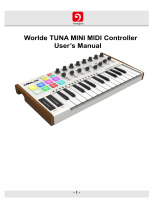
|
5
Axiom Pro User Guide
Group Controls – How do I… On Axiom Pro, press: … and refer to User Guide Page
Name the group of drum pads?
“Edit” → “3” (Group) → “P” (slider button)
“Name” parameter on pg. 34
Name the group of encoders?
“Edit” → “3” (Group) → “E” (slider button)
“Name” parameter on pg. 38
Name the group of sliders?
“Edit” → “3” (Group) → “S” (slider button)
“Name” parameter on pg. 40
Name the numerical keypad group?
“Edit” → “3” (Group) → “N” (slider button)
“Name” parameter on pg. 42
Select the MIDI channel for the drum pad group?
“Edit” → “3” (Group) → “P” (slider button)
“Channel” parameter on pg. 34
Select the MIDI channel for the encoder group?
“Edit” → “3” (Group) → “E” (slider button)
“Channel” parameter on pg. 39
Select the MIDI channel for the slider group?
“Edit” → “3” (Group) → “S” (slider button)
“Channel” parameter on pg. 40
Select the MIDI channel for the numerical keypad group?
“Edit” → “3” (Group) → “N” (slider button)
“Channel” parameter on pg. 42
Lock the velocity of drum pads?
“Edit” → “3” (Group) → “P” (slider button)
“Vel.Lock” parameter on pg. 35
Set the velocity curve of the drum pads?
“Edit” → “3” (Group) → “P” (slider button)
“Curve” parameter on pg. 35
Name one of the drum pad profiles?
“Edit” → “3” (Group) → “P” (slider button)
“1-4” parameter on pg. 37
Set the sensitivity of the encoder knobs?
“Edit” → “3” (Group) → “E” (slider button)
“Acccel. Max” parameter on pg. 39
Name one of the encoder knob profiles?
“Edit” → “3” (Group) → “E” (slider button)
“1-4” parameter on pg. 39
Toggle “drawbar” mode for the slider group?
“Edit” → “3” (Group) → “S” (slider button)
“Drawbar” parameter on pg. 41
Toggle “Null Mode” for the slider group?
“Edit” → “3” (Group) → “S” (slider button)
“NullMode” parameter on pg. 41
Zones – How do I… On Axiom Pro, press: … and refer to User Guide Page
Set the range of a zone?
“Edit” → “4” (Zone)
See pg. 43
Activate or deactivate a zone?
“Edit” → “4” (Zone)
See pg. 43
Set the MIDI output channel of a specific zone?
“Edit” → “4” (Zone) → Soft-Key 4 (Data)
“Channel” parameter on pg. 44
Set the octave shift range of a specific zone?
“Edit” → “4” (Zone) → Soft-Key 4 (Data)
“Octave” parameter on pg. 44
Set the transposition of a specific zone?
“Edit” → “4” (Zone) → Soft-Key 4 (Data)
“Transp.” parameter on pg. 44
Set the MIDI output port of a specific zone?
“Edit” → “4” (Zone) → Soft-Key 4 (Data)
“MIDI Port” parameter on pg. 45
Send a program change message for a specific zone?
“Edit” → “4” (Zone) → Soft-Key 4 (Data)
“Program” parameter on pg. 45
Send a Bank LSB change message for a specific zone?
“Edit” → “4” (Zone) → Soft-Key 4 (Data)
“BankLSB” parameter on pg. 45
Send a Bank MSB change message for a specific zone?
“Edit” → “4” (Zone) → Soft-Key 4 (Data)
“BankMSB” parameter on pg. 45
SysEx (System Exclusive) Commands – How do I… On Axiom Pro, press: … and refer to User Guide Page
Select the MIDI output port for SysEx commands?
“Edit” → “5” (MIDI)
“SysEx” parameter on pg. 46
Select the “Device ID” SysEx code?
“Edit” → “5” (MIDI)
“DevID” parameter on pg. 46
Toggle whether a “Patch ID” SysEx code is issued on Patch
changes?
“Edit” → “5” (MIDI)
“PatchID” parameter on pg. 47
Select the source of the data for the MIDI Output port on the
Axiom Pro back panel?
“Edit” → “5” (MIDI)
“MIDI Out” parameter on pg. 47
Perform a complete SysEx dump of Axiom Pro memory?
“Edit” → “5” (MIDI)
“Send All” parameter on pg. 47
Perform a SysEx dump of a specific patch?
“Edit” → “5” (MIDI)
“Send Patch” parameter on pg. 48
Send a “Snapshot” of all current controls (knobs, sliders, etc.)?
“Edit” → “5” (MIDI)
“Snapshot” parameter on pg. 48
Send a “Panic” (all notes off) message?
“Edit” → “5” (MIDI)
“Panic” parameter on pg. 48





















